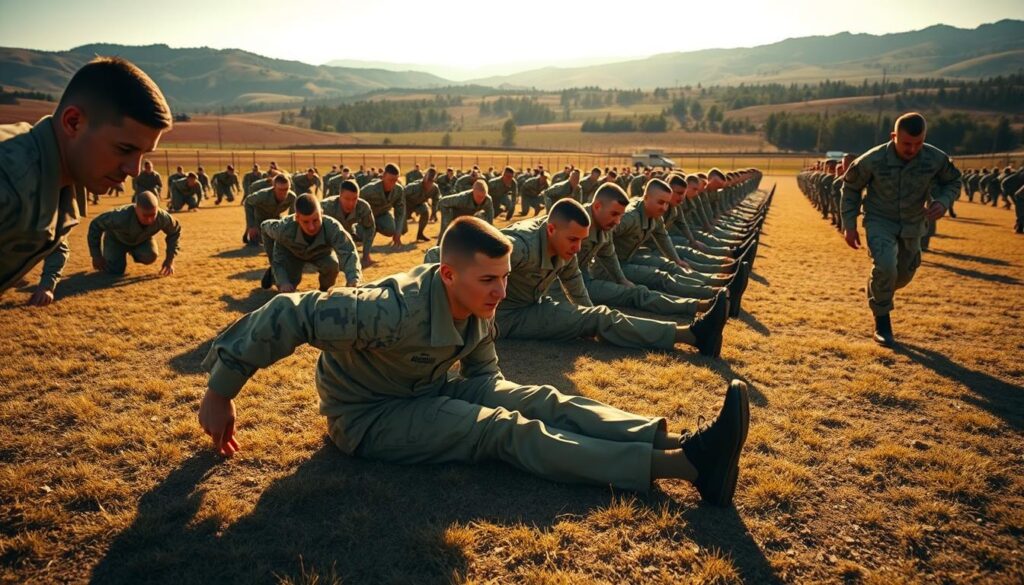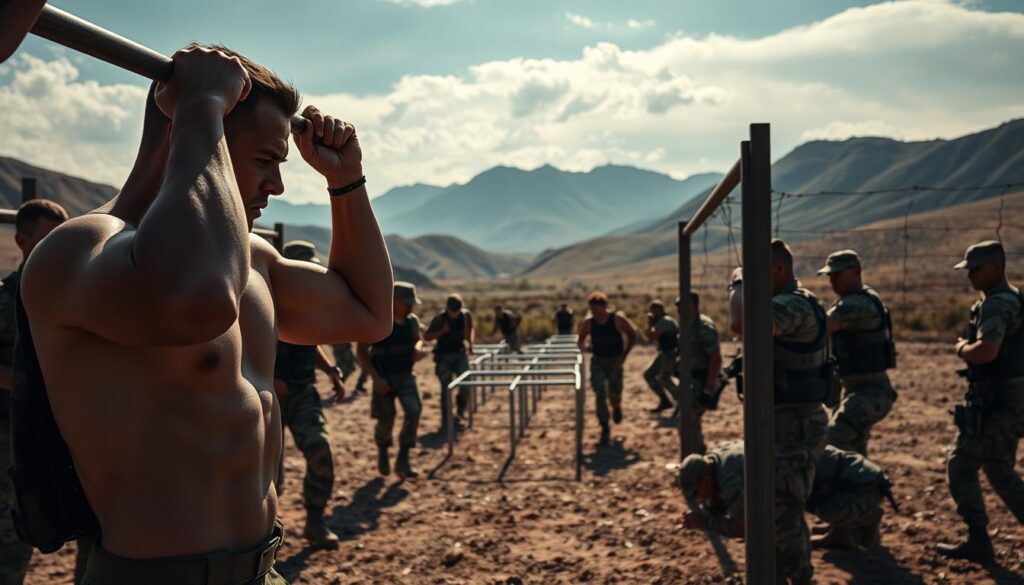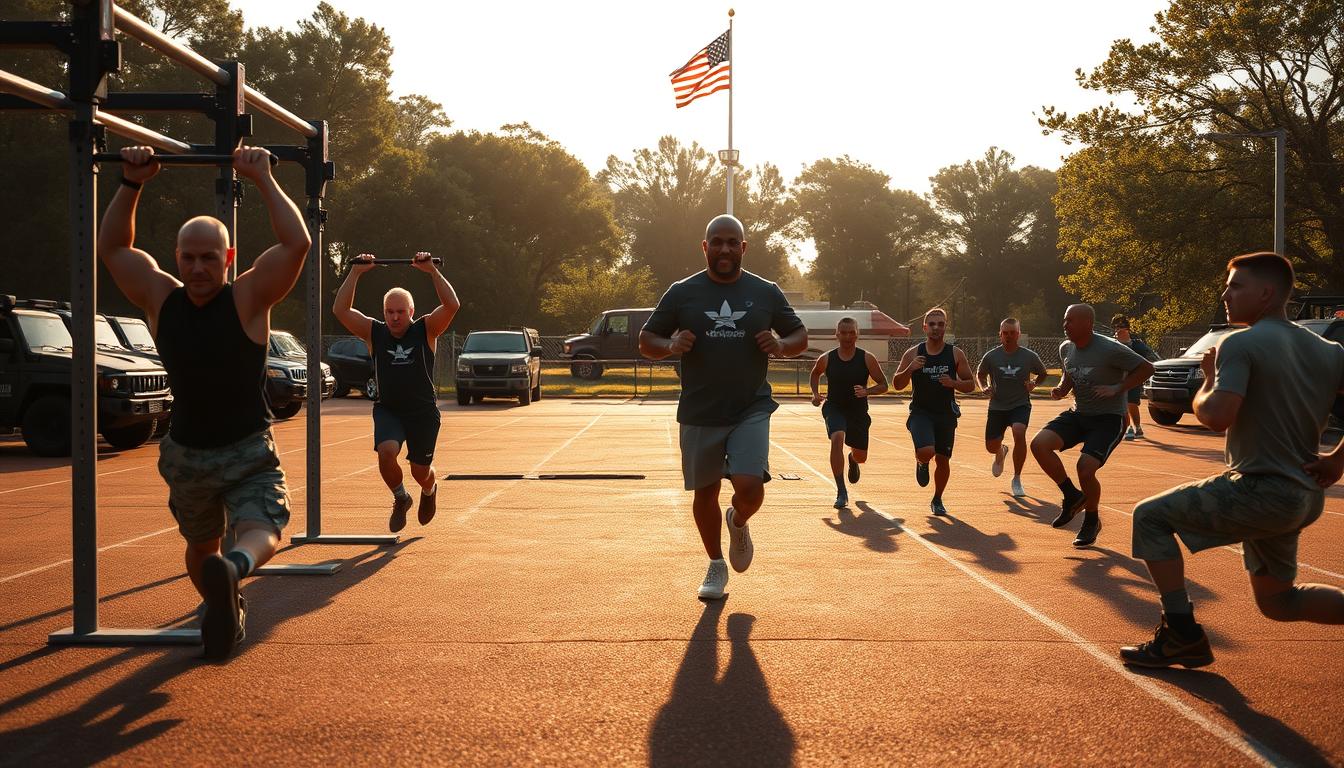The Army Fitness Test (AFT) is now the top test for soldiers’ fitness. It replaced the Army Combat Fitness Test. This change highlights the need for a full fitness program that covers strength, endurance, and agility.
For veterans, knowing the AFT is key to keeping fit and adjusting well to civilian life. The test has five parts: deadlift, hand-release push-up, sprint-drag-carry, plank, and a two-mile run.
As a veteran, learning about the AFT helps you keep up with your health and wellness goals. It uses the discipline and fitness standards you had in the military.
Key Takeaways
- The AFT is the new standard for physical fitness among soldiers.
- It includes five events that test strength, endurance, and agility.
- Veterans can benefit from understanding and preparing for the AFT.
- Maintaining AFT standards can aid in a smooth transition to civilian life.
- Staying committed to health and wellness goals is crucial for veterans.
Overview of the Army Fitness Test
The Army Fitness Test pushes soldiers to their limits. It tests their overall physical fitness. It checks strength, endurance, and agility.

Definition and Purpose
The AFT is a standardized test for the military. It checks soldiers’ physical abilities. It makes sure soldiers are ready for military service.
The test looks at different parts of physical fitness. It gives a full picture of a soldier’s fitness. For more info, visit the Army Fitness Test page.
Historical Context
The Army Fitness Test has a long history. It started with basic tests like running and strength. Now, it’s more detailed.
The test has changed with military operations. It now prepares soldiers for many tasks.
Evolution Over the Years
The AFT has changed a lot over time. Updates have made the test better. It now fits the military’s needs.
Recent updates have made the test more complete. It now tests strength, endurance, and more. The military fitness test is part of the army physical training program.
The AFT is key for soldiers’ physical readiness. It’s part of military strength and conditioning. It prepares soldiers for their duties.
Test Structure and Components
Understanding the Army Fitness Test (AFT) is key for veterans. It’s a detailed test that checks many parts of physical fitness.
Events Included in the Test
The AFT has five events. Each tests a different part of fitness. Here are the events:
- Three-repetition maximum deadlift
- Hand-release push-up arm extension
- Sprint-drag-carry
- Plank
- Two-mile run

Scoring Criteria
The AFT scores each event. The higher the score, the better the fitness.
Scoring Breakdown:
- Maximum deadlift: Measures strength
- Hand-release push-up: Assesses upper body endurance
- Sprint-drag-carry: Evaluates agility and speed
- Plank: Tests core strength and endurance
- Two-mile run: Measures cardiovascular endurance
Importance of Each Component
Every part of the AFT is important. It checks overall fitness, not just strength or endurance.
The diversity of events in the AFT helps find areas for improvement. It gives a clear plan for training and getting ready.
Special Considerations for Veterans
Veterans taking the Army Fitness Test (AFT) face unique challenges. The AFT is designed to be inclusive, recognizing the diverse backgrounds and challenges veterans face.
Adaptations for Different Age Groups
The AFT has different scoring standards for various age groups. It recognizes that physical performance changes with age. For example, older veterans are not expected to perform as well as younger ones. This ensures the test is fair and relevant for all ages.
| Age Group | Minimum Push-ups (Men) | Minimum Sit-ups (Men) | 2-mile Run Time (Men) |
|---|---|---|---|
| 17-21 | 71 | 53 | 13:00 |
| 22-26 | 71 | 53 | 13:00 |
| 27-31 | 66 | 47 | 13:18 |
| 32-36 | 60 | 41 | 13:42 |
Considerations for Injuries or Disabilities
Veterans with injuries or disabilities get special accommodations. These modifications ensure they can safely take the AFT. The goal is to assess their fitness accurately while keeping their health first.
Training Resources Available
Many training resources help veterans prepare for the AFT. There are personalized training plans, group fitness classes, and online tutorials. Veterans can also find resources for injury rehabilitation and recovery, helping them train safely and effectively.
- Personalized coaching
- Group training sessions
- Online training guides
- Injury rehabilitation programs
Preparing for the Army Fitness Test
Getting ready for the Army Fitness Test is a big job. It needs a smart plan for working out, eating right, and getting your mind ready. Veterans must do everything well to do great in the test.
Recommended Training Regimens
A good workout plan is key for the AFT. It should mix cardio, strength training, and stretching. For example, a weekly plan might be:
- Monday: Running or cardio
- Tuesday: Strength training (upper body)
- Wednesday: Rest or light activity
- Thursday: Strength training (lower body)
- Friday: Cardio or endurance
- Saturday: Rest or light activity
- Sunday: Long, slow run or rest
Make sure your workout fits your fitness level and goals. The Army’s fitness standards show what’s expected.
| Event | Minimum Standard | Maximum Points |
|---|---|---|
| 3 Mile Run | 35:29 minutes | 100 |
| Push-ups | 71 | 100 |
| Sit-ups | 78 | 100 |
Nutrition and Recovery Best Practices
Eating right is crucial for AFT prep. Eat foods with proteins, carbs, and fats. Drinking lots of water is also key.
“Proper nutrition is the foundation of physical performance. Without it, even the best training plans can fall short.”
Recovery is just as important. Get enough sleep, stretch, and use foam rollers. They help avoid injuries and get you ready for the next workout.
Mental Preparation Strategies
Mental strength is as vital as physical fitness for the AFT. Use visualization, positive self-talk, and stress management to stay focused and motivated.
By combining a solid workout plan, good nutrition, and mental prep, veterans can get ready for the Army Fitness Test. This approach boosts physical performance and overall health and wellness.
Benefits of Completing the Army Fitness Test
Finishing the Army Fitness Test (AFT) can change a veteran’s life in big ways. It’s not just about passing the test. It boosts their health and helps them connect with their community.
Physical Health Improvements
The AFT helps veterans stay fit, which is key for their health. Exercise lowers disease risks, boosts mood, and keeps them moving well. It also helps them look and feel better, as shown by the Army Height Calculator.
Social Cohesion and Community Involvement
Doing the AFT also brings veterans together. It builds a bond and a shared goal. This bond helps them adjust to civilian life, find jobs, and get involved in their communities.


